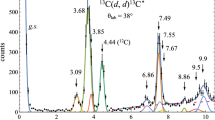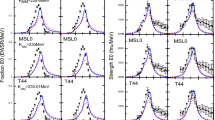Abstract.
The structure of low-lying states of the carbon isotopes is investigated using the improved version of the Antisymmetrized Molecular Dynamics (AMD) Multi-Slater Determinant model. The theoretical method is found to be very useful to study ground-state properties of various nuclei covering light unstable nuclei. The calculations succeed to reproduce reasonably well many experimental data for the carbon isotopes 12C- 22C such as binding energies, the energies of the 2+1 states in the even-even isotopes, radii and electromagnetic transition strengths. We investigate the structure change with the increasing neutron number and observe the existence of various exotic phenomena, like the development of a neutron skin and large deformations which appear in unstable nuclei. Our calculations clearly support the existence of the N = 8 and N = 16 neutron magic numbers. The role of the spin-orbit interaction in the description of the studied isotopes and in the development of cluster structures is discussed. A special approach, important for weakly bound systems, is adopted for 15C. It enables us to better describe the tail of the wave function.
Similar content being viewed by others
References
A. Ozawa, T. Kobayashi, T. Suzuki, K. Yoshida, I. Tanihata, Phys. Rev. Lett. 84, 5493 (2000).
T. Otsuka, R. Fujimoto, Y. Utsuno, B.A. Brown, M. Honma, T. Mizusaki, Phys. Rev. Lett. 87, 082502 (2001).
V. Maddalena , Phys. Rev. C 63, 024613 (2001).
D. Bazin , Phys. Rev. Lett. 74, 3569 (1995).
E.K. Warburton, B.A. Brown, Phys. Rev. C 46, 923 (1992).
T. Nakamura , Phys. Rev. Lett. 83, 1112 (1999).
R. Kanungo , Nucl. Phys. A 677, 171 (2000).
GANIL, private comunication.
Y. Kanada-En’yo, H. Horiuchi, Phys. Rev. C 54, R468 (1996).
N. Itagaki, S. Aoyama, Phys. Rev. C 61, 024303 (2000).
N. Itagaki, S. Okabe, Phys. Rev. C 61, 044306 (2000).
Y. Sugawa, M. Kimura, H. Horiuchi, Prog. Theor. Phys. Suppl. 106, 1129 (2001).
Y. Kanada-En’yo, H. Horiuchi, Prog. Theor. Phys. Suppl. 142, 205 (2001).
E. Uegaki, S. Okabe, Y. Abe, H. Tanaka, Prog. Theor. Phys. 57, 1262 (1977)
Y. Kanada-En’yo , Phys. Rev. Lett. 81, 5291 (1998).
A. Ozawa, T. Suzuki, I. Tanihata, Nucl. Phys. A 693, 33 (2001).
R. Fujimoto, PhD Thesis, University of Tokyo (2002).
N. Imai, Z. Elekes, private communication.
M. Kimura, Y. Sugawa, H. Horiuchi, Prog. Theor. Phys. 106, 1153 (2001).
R. Blumel, K. Dietrich, Nucl. Phys. A 471, 453, (1987).
N. Tajima, S. Takahara, N. Onishi, Nucl. Phys. A 603, 23 (1996).
Y. Kanada-En’yo, H. Horiuchi, A. Ono, Phys. Rev. C 52, 628 (1995).
K. Asahi , Nucl. Phys. A 704, 88c (2002).
Author information
Authors and Affiliations
Corresponding author
Additional information
G. Orlandini
Rights and permissions
About this article
Cite this article
Thiamova, G., Itagaki, N., Otsuka, T. et al. Systematic study of structure of carbon isotopes with the antisymmetrized molecular dynamics plus generator coordinate method. Eur. Phys. J. A 22, 461–470 (2004). https://doi.org/10.1140/epja/i2004-10053-5
Received:
Accepted:
Published:
Issue Date:
DOI: https://doi.org/10.1140/epja/i2004-10053-5




